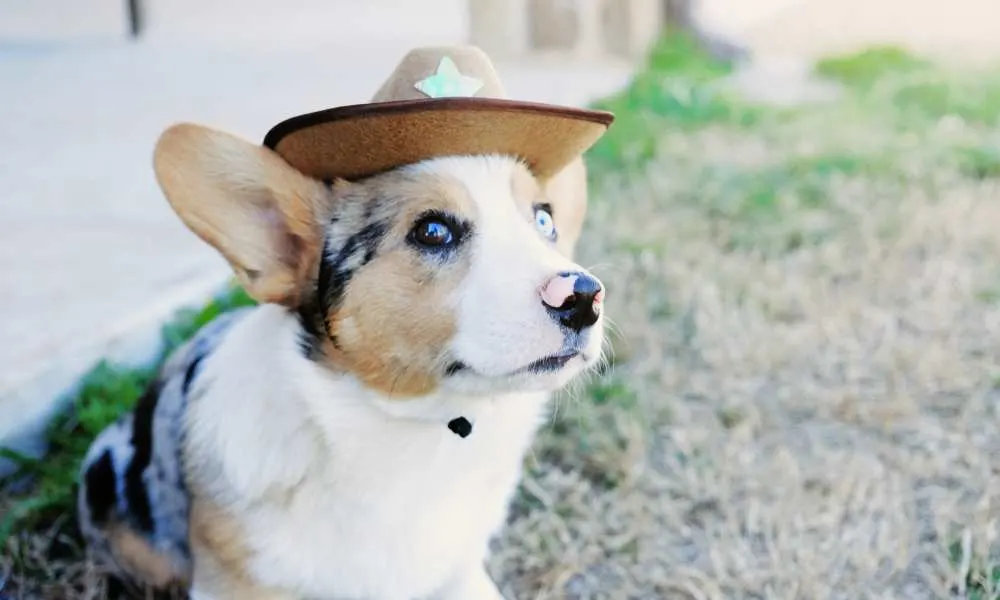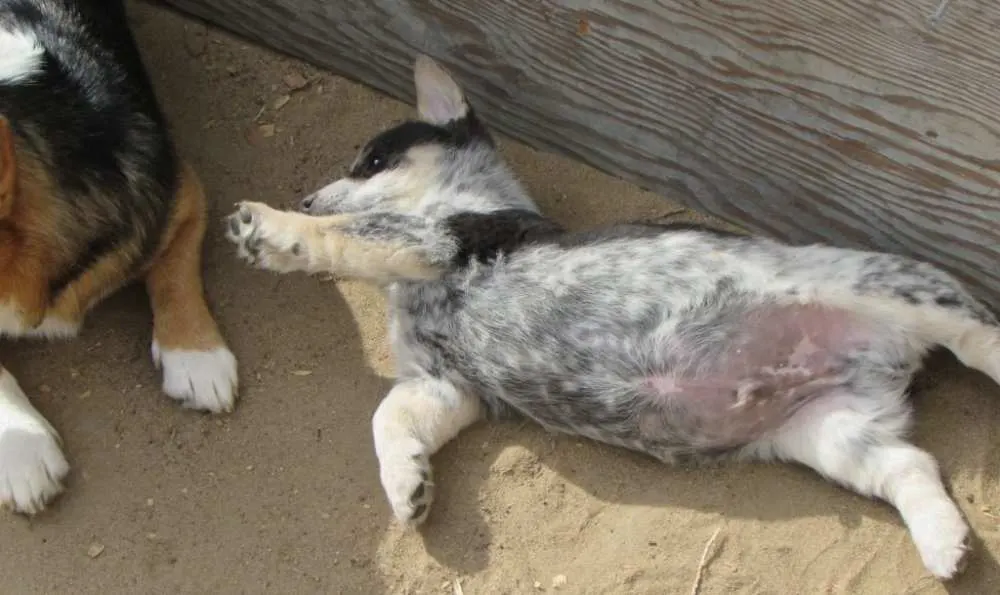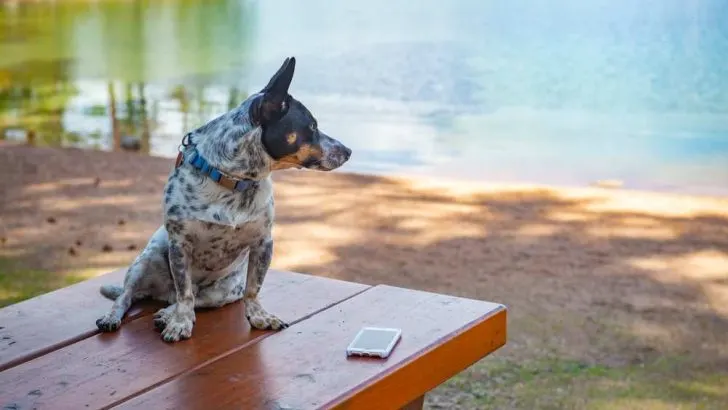Are you interested in Cowboy Corgis? Good for you!
Before you read any further, we’d like to let you in on a secret – Cowboy Corgis are mutts. They are a crossbreed between a Pembroke Welsh Corgi and a Queensland Heeler, an Australian herding dog.
So, technically, they’re not “pure” Corgis, but who cares? They are adorable, intelligent, and loyal, and that’s all that matters.
Today, we’d like to give you a brief, but detailed, introduction to this wonderful breed.
What Are Cowboy Corgis? The Physical Traits
As the perfect representation of their origin, the Cowboy Corgies’ size is between that of a Pembroke Welsh and a Queensland Heeler. These dogs are between 12-20 inches long and can weigh anywhere from 26 to 39 pounds.
Their body resembles a “regular” Corgi’s body, meaning that it’s long and barrel-shaped with big pointy ears. They’ve got short, dense hair with black, gray, fawn, and white patches. As for the eyes, they can be either blue or brown. Cowboy Corgis can live up to 15 years and are very, very energetic.

The Cowboy Corgis Temperament
As mentioned above, these dogs are super energetic and rowdy. They’re herding dogs, after all, so what else would you expect?
Cowboy Corgis like (and need) to move a lot. A large portion of their time should be spent in exercise and play. If they lack physical exertion, these pups may think of more “creative” ways to use their energy which can spell bad news for your home.
With that being said, Cowboy Corgis are not the ideal apartment dogs. Sure, you can keep them in a flat, but you’ll have to take them out fairly often. Remember, this breed is all about venting out energy daily.
These rowdy furballs love physical challenges, so feel free to take them along for a hike, jog, or any other relatively demanding activity.
Like most herding breeds, Cowboy Corgis are intelligent, independent thinkers. They’ll soak up and learn your commands with ease but won’t always follow them. The latter can be fixed if you stay consistent with training. So yes, you may need to have a bit more patience with them than with some other dogs.
Loyalty is another of their famed characteristics. It’s not uncommon for them to act aggressively towards someone they perceive to be threatful, and it’s a good idea to socialize them as early as possible.
Are Cowboy Corgis Suitable For Families?
Yes, but with proper training and socialization. Again, it’s vital to socialize them while they’re pups so that they don’t become aggressive to certain family members. Also, the children must be taught not to tease the dog too much or handle it in the wrong way.
It’s not uncommon for these dogs to start chasing squirrels in the park or mice around the yard. This is their herding instinct coming out, and they can’t help it. This kind of behavior can be mitigated by adequate training, but it cannot be completely subdued.

How To Care For A Cowboy Corgi?
Diet
When it comes to grub, Cowboy Corgis require high-quality food, either pre-packaged dog food or freshly made meals.
The crucial thing to know is that their meals shouldn’t be high in calories, or else they’ll gain weight quickly. It wouldn’t be a bad idea to consult a vet or a dog nutritionist for dietary advice specific to your pup’s size, age, and activity level.
Play and Exercise
As mentioned several times, Cowboy Corgis are an extremely active breed. With that in mind, know that they need to be out running or walking several times a day. If you’re looking for a dog to cuddle on the couch with all day, then, sorry, this one isn’t going to cut it.
If the dog’s movement needs are not met, it could become obese. Also, the dog might start tearing up your carpet or furniture out of boredom!
Grooming
If you know a bit about Corgis, you know that they’re heavy shedders, as are Queensland Heelers. So naturally, Cowboy Corgis cannot be much different than their parents.
These dogs need to be brushed daily, and they’re not for people with an allergy to dog hair. The constant grooming can be tedious at times, but, on the bright side, it is a wonderful way to bond with the animal.
Cowboy Corgi owners, don’t forget to vacuum your home thoroughly at least once a week!
Affection
Cowboy Corgis don’t only look snuggly and affectionate – that’s how they are. These dogs absolutely love to cuddle, scratch, and everything in between, so be sure to provide them with a lot of that!
What you should never do is hit or emotionally neglect your dog. Taking out your anger on it will make it fearful and possibly even aggressive towards you. As with every other dog, it’s crucial that the animal recognizes you as the alpha. However, violent treatment is no way to do that!

Common Health Problems
Like most dog breeds, Cowboy Corgis may encounter certain health issues during their lifetime. The ones that you should keep an eye out for include:
- Hip Dysplasia – this is a condition that dogs might develop as they grow. The hip joint becomes loose and leads to hip pain and limb dysfunction.
- Intervertebral Disk Disease (Slipped disc)– dogs with long bodies are prone to this issue.
- Deafness – a genetic disease that Cowboy Corgis inherited from the Queensland Heeler. The dog will be more prone to it if it has more Queensland Heeler than Corgi genes.
- Progressive Retinal Atrophy – also known as PRA or night blindness. It eventually leads to total (day) blindness.

How To Train A Cowboy Corgi?
Being highly intelligent dogs, Cowboy Corgis are pretty easy to train. Of course, the amount and type of training required depends on what you plan to do with the dog.
Those who want to use these dogs for their inherent purpose, herding, should start training them as young as possible. The pup needs to learn basic obedience skills to make further training possible and effective.
Even if you don’t want your Cowboy Corgi to herd, it’s advisable to practice some kind of “free form” training. They love mental stimulation and thrive from learning new things/skills.
If you don’t know what to teach the dog, start with the classics – stay, sit, roll over, etc. They’ll be so thrilled when they acquire a new trick. Once you see how happy it makes them, you’ll want to do it over and over!
Since your dog (probably) won’t be herding, it must get enough exercise. You can help by teaching it to play fetch. This isn’t just a great way for the pup to exert all that energy but also for you two to bond.
Now, the tricky thing with this breed is that it doesn’t always want to follow rules. It learns them quickly but fails to obey them 100% of the time. This is where a professional trainer could come in handy.
A trainer would ensure that your dog starts doing what you command it to do. Also, he or she can teach the dog to suppress its herding instinct so that it doesn’t go chasing after every small animal it encounters.

About Cowboy Corgis’ Parent Breeds
To fully understand what the Cowboy Corgi is, it’s helpful to know more about how this cross breed came to be. In this section, we will take a closer look at its parent breeds and their main features.
Australian Queensland Heeler
As you know by now, Queensland Heelers are herding dogs that hail from Australia. They have been bred to be loyal, which is their primary and most treasured trait.
Their loyalty is best reflected in the fact that these dogs are almost always close to their owner. They’re very intelligent and highly energetic, as both qualities are needed to drive cattle successfully.
When it comes to their dimensions, Heelers are medium-sized dogs whose height spans from 17 to 20 inches. As for the weight, it can go anywhere from 30 to 50 pounds. Their coat is short, and it’s either red or blueish gray.
Pembroke Welsh Corgi
As its name implies, the Pembroke Welsh Corgi originated in Pembrokeshire, Wales. Like the Queensland Heeler, this is also a herding breed, so you can expect it to be intelligent. It was bred to help their owners herd sheep, horses, as well as cattle.
Their physical characteristics are as follows:
- They can have red, black, fawn, or multi-colored hair.
- They’ve got a thick double coat which they shed twice a year.
- Given that they have so much hair, Pembroke Corgis tend to overheat quite easily.
- These dogs’ maximum height is 12 inches, and their weight usually doesn’t go over 27-28 pounds.

